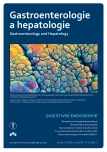Neuroendocrine neoplasms in gastroenterologist practice
Authors:
M. Šachlová
Authors place of work:
Gastroenterologické oddělení, Masarykův onkologický ústav, Brno
Published in the journal:
Gastroent Hepatol 2016; 70(3): 220-225
Category:
Digestivní endoskopie: přehledová práce
doi:
https://doi.org/10.14735/amgh2016csgh.info04
Summary
Gastrointestinal neuroendocrine neoplasms are relatively rare tumors. They are often slow growing tumors derived from the diffuse endocrine system. A number of synonyms have been used for these tumors. Neuroendocrine tumors are now classified according to their site of origin and defined broadly according to their differentiation, whether they are functional or nonfunctional, their proliferative rate in terms of mitotic rate or K-67 labelling index, and their malignant potential. Advances in imaging are 3-phase CT, MRI, double-balloon enteroscopy, capsule endoscopy, and somatostatin receptor imaging. Patients with neuroendocrine tumors should be taken care of by a multidisciplinary team.
Key words:
neuroendocrine neoplasm – neuroendocrine carcinoma – somatostatine receptors – carcinoid syndrome
The author declares he has no potential conflicts of interest concerning drugs, products, or services used in the study.
The Editorial Board declares that the manuscript met the ICMJE „uniform requirements“ for biomedical papers.
Submitted:
26. 10. 2015
Accepted:
22. 1. 2016
Zdroje
1. Sedláčková E. Neuroendokrinní nádory. In: Tomášek J et al (eds). Onkologie – minimum pro praxi. Praha: Axonite 2015: 237– 250.
2. Louthan O. Neuroendokrinní nádory. Praha: Grada Publishing 2006: 22– 216.
3. Delle Fave G, Kwekkeboom DJ, Van Cutsem E et al. ENETS consensus guidelines for the management of patients with gastroduodenal neoplasms. Neuroendocrinology 2012; 95(2): 74– 87. doi: 10.1159/ 000335595.
4. Scherübl H, Cadiot G, Jensen RT et al. Neuroendocrine tumor of the stomach (gastric carcinoids) are on the rise: small tumors, small problems? Endoscopy 2010; 42(8): 664– 671. doi: 10.1055/ s-0030-1255564.
5. Falconi M, Bartsch DK, Eriksson B et al. ENETS consensus guidelines for the management of patients with digestive neuroendocrine neoplasms of the digestive system: well-differentiated pancreatic non-functioning tumors. Neuroendocrinology 2012; 95(2): 120– 134. doi: 10.1159/ 000335587.
6. Novotný I. Endoskopická retrográdní cholangiopankreatikografie (ERCP) a endoskopická ultrasonografie (EUS). In: Kala Z et al (eds). Nádory podjaterní oblasti. Diagnostika a léčba. Praha: Grada Publishing 2009: 45– 55.
7. Jensen TR, Cadiot G, Brandi ML. ENETS Consensus guidelines for the management of patients with digestive neuroendocrine neoplasms: functional pancreatic endocrine tumor syndromes. Neuroendocrinology 2012; 95(2): 98– 119. doi: 10.1159/ 000335591.
8. Hoffmann KM, Furukawa M, Jensen RT. Duodenal neuroendocrine tumors: classification, functional syndromes, diagnosis and medical treatment. Best Pract Res Clin Gastroenterol 2005; 19(5): 675– 697.
9. Witzigmann H, Loracher C, Geissler F et al. Neuroendocrine tumours of the duodenum: clinical aspects, pathomorphology and therapy. Langenbecks Arch Surg 2002; 386(7): 525– 533.
10. Lukáš M. Diagnostické postupy u karcinoidů v gastrointestinální lokalizaci. In: Petruželka L (ed). Karcinoid. Praha: Maxdorf 2004: 25– 29.
11. Pape UF, Perren A, Niederle B et al. ENETS consensus guidelines for the management of patients with neuroendocrine neoplasms from the jejuno-ileum and the appendix including goblet cell carcinomas. Neuroendocrinology 2012; 95(2): 135– 156. doi: 10.1159/ 000335629.
12. Caplin M, Sundin A, Nillson O et al. ENETS consensus guidelines for the management of patients with digestive neuroendocrine neoplasms: colorectal neuroendocrine neoplasms. Neuroendocrinology 2012; 95(2): 88– 97. doi: 10.1159/ 000335594.
13. Niederle M, Hackl M, Kaserer K et al. Gastroenteropancreatic neuroendocrine tumours: the current incidence and staging based on the WHO and European neuroendocrine tumour society classification: an analysis based on prospectively collected parameters. Endocr Relat Cancer 2010; 17(4): 909– 918. doi: 10.1677/ ERC-10-0152.
14. Modlin IM, Lye KD, Kidd M. A 5-decade analysis of 13 715 carcinoid tumours. Cancer 2003; 97(4): 934– 959.
15. Modlin IM, Kidd M, Latich I et al. Current status of gastrointestinal carcinoids. Gastroenterology 2005; 128(6): 1717– 1751.
16. Louthan O. Neuroendokrinní nádory rekta. Klin Onkol 2009; 22(5): 195– 201.
17. Kinoshita T, Kanehira E, Omura K et al. Transanal endoscopic microsurgery in the treatment of rectal carcinoid tumor. Surg Endosc 2007; 21(6): 970– 974.
18. Onozato Y, Kakizaki S, Lizuka H et al. Endoscopic treatment of rectal carcinoid tumors. Dis Colon Rectum 2010; 53(2): 169– 176. doi: 10.1007/ DCR.0b013e3181b9db7b.
19. Ramage JR, Gooretzki PE, Manfredi R et al. Consensus guidelines for the management of patiens with digestive neuroendocrine tumours: well-differentiated colon and rectum tumour/ carcinoma. Neuroendocrinology 2008; 87(1): 31– 39.
20. Oberg K. Neuroendocrine gastrointestinal tumours. Ann Oncol 1996; 7(5): 453– 463.
21. Matsumoto T, Iida M, Suekane H et al. Endoscopic ultrasonography in rectal carcinoid tumors: contribution to selection of therapy. Gastrointest Endosc 1991; 37(5): 539– 542.
Štítky
Detská gastroenterológia Gastroenterológia a hepatológia Chirurgia všeobecnáČlánok vyšiel v časopise
Gastroenterologie a hepatologie

2016 Číslo 3
- Metamizol jako analgetikum první volby: kdy, pro koho, jak a proč?
- Fixní kombinace paracetamol/kodein nabízí synergické analgetické účinky
- Antidepresivní efekt kombinovaného analgetika tramadolu s paracetamolem
- Geriatrická křehkost a léčba bolesti
- Tramadol a paracetamol v tlumení poextrakční bolesti
Najčítanejšie v tomto čísle
- Stenóza tlustého střeva neobjasněné etiologie
- Mutaflor® – Escherichia coli (Nissle 1917), sérotyp O6:K5:H1 – nejlépe prozkoumané probiotikum současnosti
- Endoskopické řešení volvulu sigmatu
- Neuroendokrinní nádory v gastroenterologické praxi
